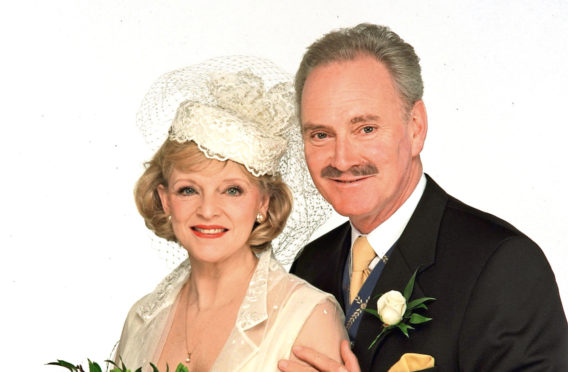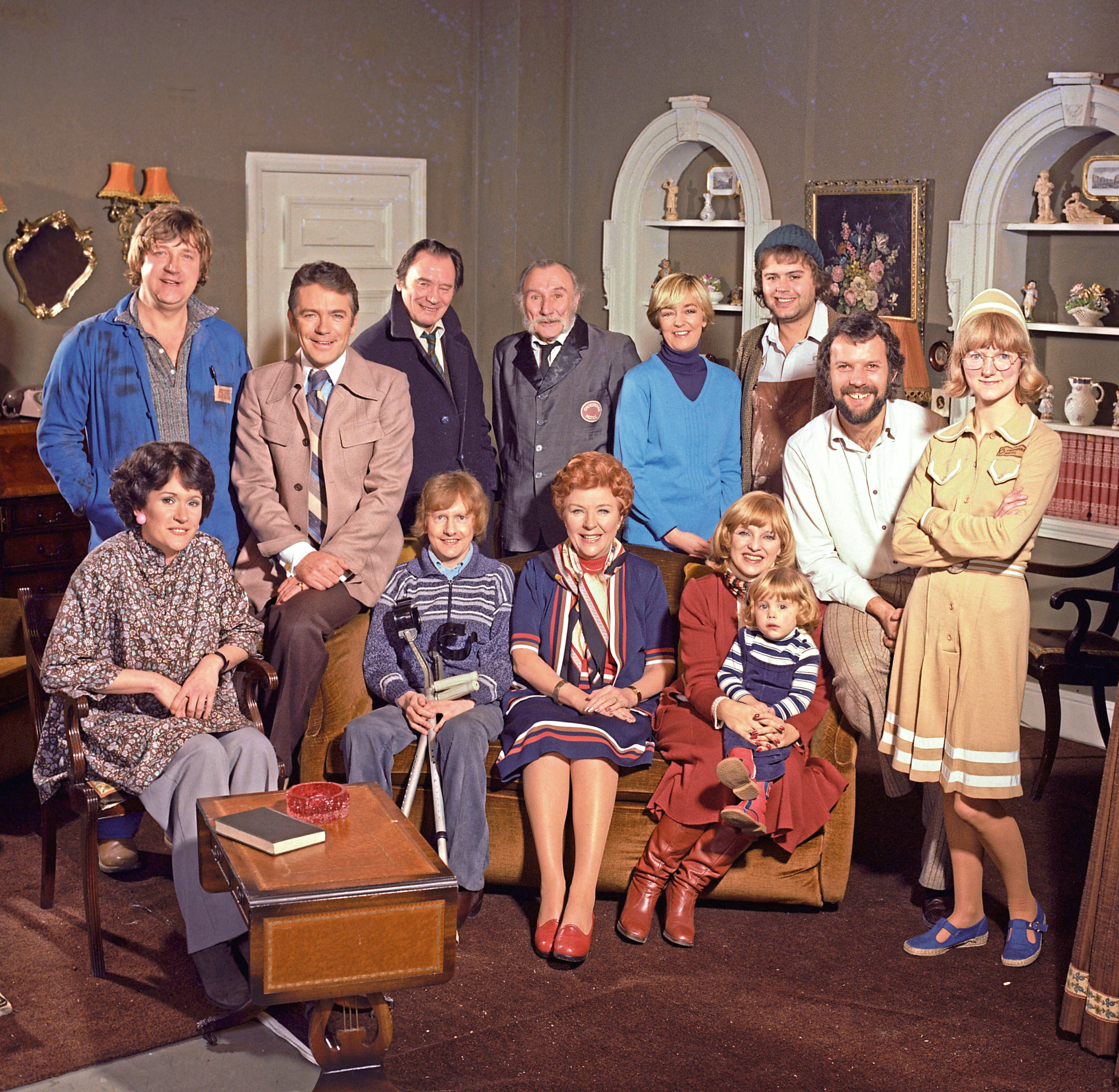
Despite being slated by critics, Midlands-based soap Crossroads ran for more than two decades and was cherished by millions.
Nearly 5,000 episodes were made between 1964-88, each spotlighting the daily goings-on at the fictitious motel.
Two of the soap’s most popular characters were Jill and Adam Chance, played by Jane Rossington and Tony Adams. While Jill was the hardworking daughter of motel owner Meg Richardson, Adam was a wily, womanising accountant.
Both actors had plenty of fun making Crossroads, despite tension existing in the studio, thanks to the pressures of filming.
“I remember recording a dinner party scene which was a nightmare,” recalls Jane, 75. “Nowadays a director would never use more than one camera, but we had four.
“Everyone in the scene, including me, was sat down and couldn’t lean forwards or backwards because we’d be moving into someone else’s shot.
“We were almost at the edge of hysteria, just waiting for it to go terribly wrong. Eventually, we reached the end of the scene, after which they cut away to the next sequence, being filmed just 20 yards away.
“In the euphoria that we’d got through our scene correctly, the actor opposite me got up, turned and walked straight into the set. All the pictures fell off the wall.
“Fortunately, it was out of shot, but there was a terrific crash. We’d got through our horrendous scene only for that to happen.
“But things like that occurred often and we’d all be lying on the floor, trying not to laugh, like the time I was in a scene doing something at a sink.
“The cameraman was shooting over the sink, and up until that point we didn’t have running water. When it came to the take the supply had been switched on but I suddenly realised I’d pulled the plug out and there wasn’t a bucket underneath. Water gushed everywhere but we just carried on.”
That was Crossroads – and there’s been no other soap like it.
By the time Tony Adams was cast as Adam Chance, he’d already appeared in the popular ’70s series General Hospital, playing Neville Bywaters.
“Adam was great fun to play because he was unpredictable and changed personality frequently – sometimes alarmingly,” remarks Tony, now 78. “There was a dark side to him, which was much more interesting than being Mr Nice all the time.”
Although Tony received piles of fan mail, Valentine cards and even proposals of marriage, his character wasn’t universally liked.
“One man was so upset at the way Adam treated Miranda Pollard, one of his numerous girlfriends, that he sneaked into the studios and charged at me with a knife,” recalls Tony.
“Luckily, two security guards were nearby and I was unhurt. But it shook me up for a time.”
Tony was fully aware of the bad press the soap received but didn’t let it affect his performance. “The criticism upset Noele Gordon but I kept telling her that it didn’t matter when we were regularly watched by nearly half the UK population.
“She was a lovely, caring person – the leader of the show. No one could believe it when bosses got rid of her.
“Part of the fun of the programme, though, was that anything could happen – and invariably did!”
The cast became experts in disguising the unexpected glitches. In one scene, Noele Gordon should have been pouring tea but played the entire scene standing against a safe door that kept swinging open.
Despite such incidents, Tony regards Crossroads as among the highlights of his career. “I was proud to play Adam and even now, years later, still get recognised in the street and receive letters from people about the show.”
Jane Rossington stayed with the soap through its 24-year life. Not bad considering she was originally told the job would run for just six weeks!
“I’d been in Emergency Ward 10 before going into rep at York to do a play. The same casting director who’d hired me in Ward 10 was casting Crossroads and remembered that I came from the Midlands.”
She attended an audition, during which her shopping bag split and tins of baked beans rolled across the floor. But the embarrassing moment didn’t ruin her chances and she was hired – and it couldn’t have happened at a more fortuitous moment.
“The chap employing me in rep wasn’t paying my full salary. I kept saying: ‘I’m a bit short.’ I was getting cross so when Crossroads came up it was a good chance to say: ‘I don’t care now because I’m going off to do something else.’”
Although the character of Jill was standard fare to begin with, Jane was pleased with how she matured.
“It was a young girl-next-door type of role, so not much to do, but the character developed and became more fun. I had some very nice light comedy material, particularly towards the latter days.”
The character suffered her fair share of heartache, too. “Three marriages, an affair with her stepbrother, two miscarriages, a nervous breakdown, suicide attempts – everything happened to her!”
Another popular character was waitress Glenda Brownlow, played by Lynette McMorrough, now 60.
“I was offered the role on my 21st birthday, in the late ’70s. Until then I’d mainly worked in theatre. But my mother and I watched Crossroads when I was still at school, so to end up working on it was brilliant.”
Lynette regarded Crossroads as ahead of its time. “While EastEnders and Emmerdale pride themselves on storylines covering topical issues, Crossroads did that years before.”
One of the biggest stories involved Glenda and husband Kevin’s inability to have children. Back in the ’80s, test-tube babies were still a hot topic so when Glenda and Kevin’s daughter was born by in-vitro fertilisation, it broke new ground in soaps.
“To help with research, we met a couple who’d just had a test-tube baby. What was satisfying was receiving many letters from couples who’d been inspired by the storyline to explore the possibilities for themselves.”
The baby’s arrival in 1983 was well timed because Lynette was pregnant in real life. “I didn’t have to stop work as my daughter, Emily, was able to play my screen baby, Katy-Louise.
“I’ve nothing but good memories of playing Glenda, despite the fact she always moaned and her life was full of doom and gloom.”
Glenda, like many other characters, fell victim to sweeping changes in the ’80s that were made in a desperate attempt to rescue the soap.
“It was painful to leave because I’d been in it throughout my 20s. But it forced me into the outside world and meant having to re-establish old contacts.
“People still recognise me. Sometimes, I notice people staring and, although they can’t place me, they know they’ve seen the face before.”
The original format, which ran from 1964-88, underwent several makeovers during its lifetime, including the motel being transformed into a country hotel. But by the mid 1980s it was struggling for viewers.
On April 4 1988, the final episode – or so everybody thought – was screened. Some 12 years later, Crossroads’ ill-fated revival happened when ITV commissioned a new version. Both Jane and Tony returned.
“It was great fun appearing as Adam Chance again,” says Tony. “The sets were magnificent and we had wonderful clothes – in the original series we had to provide our own!
“Sadly, it didn’t last. If it had been given more time and called something different, I think it could have worked. Perhaps some people who fondly remembered the original were expecting to see the likes of Miss Diane again.”
Jane adds: “The company had all this money and spent a million pounds on the set, thinking it would attract viewers. In the original, we didn’t spend any money on the set yet people still watched.”
During the 24 years the original series ran, more than 20,000 actors appeared in the show. Some proved cynics wrong by showing there was life after Crossroads by forging successful careers for themselves. Others were household names before even setting foot inside the motel.
David Jason played a gardener in the late 1960s while singer Elaine Paige was still at drama school when she appeared. Other notable names included Max Wall, Ken Dodd, Bob Monkhouse and Larry Grayson.


Enjoy the convenience of having The Sunday Post delivered as a digital ePaper straight to your smartphone, tablet or computer.
Subscribe for only £5.49 a month and enjoy all the benefits of the printed paper as a digital replica.
Subscribe © ITV/REX/Shutterstock
© ITV/REX/Shutterstock © ITV/REX/Shutterstock
© ITV/REX/Shutterstock